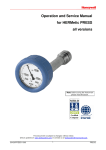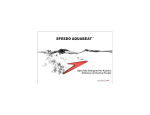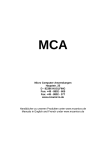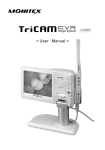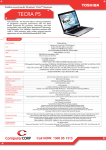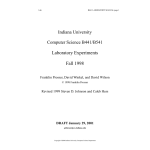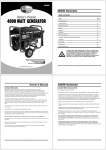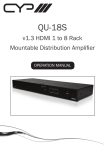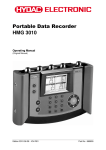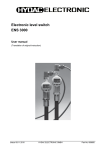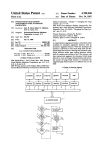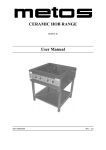Download 82386 HUGLFING Fon - apex
Transcript
MCA Micro Computer Anwendungen Hauptstr. 25 D - 82386 HUGLFING Fon: +49 - 8802 - 605 Fax: +49 - 8802 - 377 www.mcamicro.de Handbücher zu unseren Produkten unter www.mcamicro.de Manuals in English and French under www.mcamicro.de DSG-2S USER MANUAL. DSG-2S is used to load and save NC programms etc. It works in conjunction with all CNC machines having an RS232/V24 serial interface or a 20 mA current loop. In general: DSG-2S should be rack mounted. Front panel: Floppy station for HD and DD disks with automatic media recognition. Display illuminated with 2 lines 20 digits each. User dialog selectable in German, English and French. 5 keys with multifuction: 1. Transmit or YES 2. Receive or NO 3. Auxillary (Aux) or arrow left (go back) or select channel 1 4. Index ( step through disk directory) or arrow right (go forward) or select channel 2 5. C: go to basic state Rear: Selectable main supply 115 - 240 VAC, 50/60Hz, 5VA 9 Pin male sub D for channel 1 to CNC ( RS232/V24 only) 25 Pin female sub D for channel 2 to CNC (RS232/V24 or 20mA current loop) Pls view diagrams for pin description. When set is powered up unconfigured, user dialog is in German. Display shows: DSG-2S V3.5 as first line and date and time as second line. To select another user dialog language, do as follows: 1. Press AUX key several times till display reads PARAMETER. 2. Confirm by key YES. Display reads now DEUTSCH. 3. Press key NO as often till display shows ENGLISH in first line. 4. Confirm by key YES. Display shows now CHANNEL 1, press key C. The user can anytime press the C key in all operations to get back to the basic state and start all over! Configuration of RS232/V24 channels 1 or 2. (PARAMETERS). DSG-2S can operate with two CNC machines connected to channel 1 and 2 simultaniously. Before using the DSG-2S in conjunction with a CNC machine one or two data cables should be prepared and connected to the data channels of the DSG-2S. Configuration menu (Parameters) is used to setup once all RS232 parameters like baud rate (75 to 19200 Bd), Data format (8N1, 8N2,7E1,7E2,7O1,7O2. N=no parity, E=even parity, O=odd parity; Example: 7E1 means: 7 Data bits, even parity, 1 stop bit; 8N2 means 8 data bits, no parity, 2 stopbits etc.), Handshake: software: X-on/X-off. Filter fuctions: 2 Input filters / Output filter; File START character; File END recognition procedure; FILE-LENGTH: minimum file lenght; file NAME assignment methode; 810 Control; DIR: directory ( root or sub directory) and date and time setting. Press AUX key several times till display shows PARAMETERS and confirm by key YES. If display shows ENGLISH confirm by YES (if not see above). Display shows channel 1 ; confirm by YES to setup channel 1 or confirm by NO to got to channel 2 setting and reconfirm by YES again. BAUDRATE: use arrow keys to select baudrate and confirm by YES. DATA FORMAT: use arrow keys and confirm by YES. Important: Baudrate and Data Format must be the same for CNC and DSG-2S! X-ON/X-OFF: use NO key to toggle between ON/OFF and confirm selection by YES if this mode should be selected. It is mandatory that CNC operates in the same mode! Pls. note Hardware handshake RTS/CTS is enabled permanently. If not used, simply RTS/CTS wires in the data cable ( 2 wires ) are left unconnected! DSG-2S needs either RTS/CTS or XON/X-OFF handshake otherwise overrun errors occur and data is partly lost on receive. Input filters are used to remove a special character from a file received from the CNC before storing to disk. Usually many CNC machine send NUL before and after a CNC program which can be removed since they contain no information. I1-FILTER: use NO key repeatedly to select between no function (---) or filter character. Select character by arrow keys. Confirm by YES. Normal setting no function (---)! I2-FILTER: same as I1-Filter. Output filter allows suppression of a character (usually NUL) in a file sent to the CNC. O-FILTER: use no key repeatedly to toggle between no function (---) or filter character. Selected character by arrow keys. Confirm by YES after selection. Normal setting (---)! File start character setting is used to start recording a CNC program after a special character received ( example: % ). All characters received before % are discarded. START: use NO key to toggle between no function (---) and character. Select character by arrow keys and confirm selection by YES. Normal setting (---)! File END condition: for received CNC program end condition. 3 possibilities do exist: 1. END:TIMEOUT=6sec means: if sending a program from CNC to DSG-2S and the data stream pauses for more than 6 sec an end if transmission is recognized and recorded file is closed. Select time in seconds by arrow keys and confirm by YES. 2. END: OPEN: DSG-2S remain permanently in receive mode and must be closed manually. Confirm selection by YES keys. 3. END: by special end character received (usually ETX). Select character by arrow keys and confirm by YES. Please note: Exept for very special cases select TIMEOUT 6 SEC! FILE-LENGHT > 3: If less than 3 characters are received from CNC, it is recognized as invalid CNC program and is not written to disk! Select minimum file lenght by arrow keys and confirm by YES. Usual setting about 3 characters. Before receiving a CNC program for storage to disk, a program name must be given. This name is entered into the directory. There are 4 possibilities for assignment of program names: NAME: File-xxx: The first file received automatically gets name FILE-001, the second file recorded to disk FILE-002 and so on, i.e. Program names are assigned automatically in autoindexed mode. NAME FOLLOWS PASSWO: means for example: The CNC program always starts with program name % and a 4 digit program name like %1234. When the sequence %1234 is received, DSG-2S extracts the next 4 digits after delimiter % and uses them as program name. This means, that program name in the CNC program is used a file name on the disk. Confirm by YES, select delimiter one or more characters by arrow keys, confirm each character by YES, terminate by NO (END, second line of display), select number of digits after delimiter by arrow keys and confirm by YES. With this setting program name is given automatically from CNC program received! NAME: PASSWORD/HUK. This is a special setting for CNC machines from Heckler&Koch (BWO) machine controls. The CNC program name always starts with P and a 4 digit number. NAME: INPUT BY KEYS: This means, when a CNC program is received, a program name has to be entered manually each time. For convenience of operation we propose to use either NAME: FILE-xxx or NAME: FOLLOWS PASSWORD mode. In these modes program names are assigned automatically. 810-CONTROL: A special SPS interface card must be installed in a Siemens 810 to allow this operation. DSG-2S also needs an additional parallel interface. To use the DSG-2S on a 810 without this card set 810-mode to OFF! Toggle between ON/OFF by NO key and confirm by YES. DIR: ROOT DIRECTORY: Select your preferred directory (if available) and confirm by YES. Date and Time setting: All files recorded to disk contain date and time. To change the date and time setting press NO key, change each setting by arrow keys, confirm by YES. Exit parameter setting by key C. Key AUX general function selection: Repeatedly pressing AUX key shows following functions in the display: PARAMETERS: see above. WRITE PARAMETERS: All parameters, when confirmed by YES are written to disk into a file mode-2b. If parameters got changed by unqualified manipulation, it is possible to retrieve original settings from file mode-2b by function read parameters. READ PARAMETERS confirmed by YES key. If a file mode-2b is found on disk, all parameters are loaded and confirmation by PARAMETERS LOADED is indicated in the display. CHANGE DIRECTORY: If a disk has several directories, the preferred directory from which CNC programs are loaded or stored is selected here. DELETE FILE: Delete a file previosly selected by INDEX key. RENAME FILE: Change name of a file. CLOSE CHANNEL: If no file end was recognized or DSG-2S is in auto receive mode, a file received must be closed manually. Confirm by YES, select channel to be closed ( 1 or 2) and FREE sign will appear in the second display line. FORMAT DISK: Confirm by YES twice. Note: all information on disk is lost after this function! Also note: DSG-2S can use PC formatted disks also. This means all data on disk is read and writable by a PC. TRANSMIT INDEX and TRANSMIT all Files are utility functions. Connect a printer with RS232 port to a selected channel for documentary purposes. Operation in general: Key INDEX is used to select a file to be sent to the CNC machine. Repeatedly pressing the INDEX key steps through the directory in ascending form. Stepping back is done by the left arrow key. Sending a program to the CNC: Select a machine program via INDEX key. Put CNC into receive mode. Press TRANSMIT key. Display shows: TRANSMIT TO CHANNEL. Enter channel number 1 or 2. Program is sent to the CNC. Red/geen leds are blinking to indicate data transfer via serial channel. Receiving a program from CNC and storing to disk: With parameter setting for channel with program name selection in index mode (File-xxx) or program name from file received. Press RECEIVE key. Display shows: RECEIVE ON CHANNEL x. Enter channel number (key 1 or 2). Set CNC into transmit mode. Red/green led blinks to indicate data being received over the serial channel. In mode NAME: INPUT BY KEYS: Press RECEIVE key. Display shows: RECEIVE ON CHANNEL x. Enter channel number (key 1 or 2). Enter program name by arrow keys, confirm each entry by YES and last entry by END. Set CNC into transmit mode. Red/green leds are blinking when data is received. Selftest of DSG-2S and test of RS232 channel 1 and 2: Prepare a DB9 female connector for test on channel 1 and a DB25 male connector for test on channel 2 ( see diagram ) and connect to channels. Keep key TRANSMIT pressed while applying power to the DSG-2S. If there are no errors, second display line should remain blank! Test mode is removed by disconnecting power. Pls note: after a selftest DSG-2S must be reconfigured! Before doing selftest it is advisable to save configuration on disk by funktion PARAMETER WRITE and after selftest restore parameters by function PARAMETER LOAD. $ % & ' *1' &76 *1' 576 *1' /RRS &76 576 5;' 7;' WRUHPRWH*1' P$5;LQIURPUHPRWH7; /RFDOP$LQ P$7;RXWWRUHPRWH5; P$ 9 '6*6,17(51$/ P$ 9 '6*6,17(51$/ *1' 6LJQDO*URXQG 3URWHFWLYH(DUWK 576 &76 *1' 7;' 7HVWSOXJ'%IHPDOHIRU&KDQQHO 5;' &+$11(/'$7$&RQQHFWRU'%PDOH '%PDOH &?3URJUDP)LOHV?'HVLJQ([SORUHU6(?,06?,06GGE 'UDZQ%\ 6KHHWRI $SU )LOH 1XPEHU &DEOLQJ'6*6 7HVWSOXJ'%PDOHIRU&KDQQHO '%PDOH 'DWH $ 6L]H &1&6,(0(16 '6*6 *1' 7LWOH &76 576 7;' 576 &76 '%PDOH &76 5;' 5;' 5;' '%IHPDOH 576 7;' '$7$&DEOH'6*6&KDQQHO 7;' &1&6,(0(16 7;' '$7$&DEOH'6*6&KDQQHO '6*6 5;' &+$11(/'$7$&RQQHFWRU'%IHPDOH 5HYLVLRQ $ % & '







